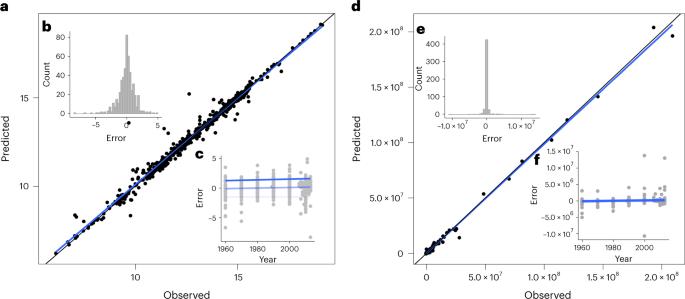Likely decline in the number of farms globally by the middle of the century
IF 25.7
1区 环境科学与生态学
Q1 ENVIRONMENTAL SCIENCES
引用次数: 3
Abstract
Farm number and size are deemed important for a variety of social and environmental outcomes, including yields, input use efficiencies, biodiversity, crop diversity, climate change and concentration of power in food systems. Using a model incorporating theoretical drivers of the creation and consolidation of farms within countries, I historically reconstruct the number of farms on Earth over 1969–2013 and predict their future evolution. I show that under current development trajectories, the number of farms globally will probably decline from the current 616 million (95% CI: 495–779 million) in 2020 to 272 million (95% CI: 200–377 million) by the end of the twenty-first century, with average farm size doubling. In some regions, such as Europe and North America, we will see a continued decline from recent history, whereas in other regions, including Asia, Middle East and North Africa, Oceania, and Latin America and the Caribbean, we will see a turning point from farm creation to widespread consolidation. The turning point also occurs for sub-Saharan Africa, but much later in the century. This world in which significantly fewer large farms replace numerous smaller ones carries major rewards and risks for the human species and the food systems that support it. By reconstructing the number of farms on Earth over 1969–2013, this study shows that under current development trajectories, the number of farms globally will probably halve by the end of the twenty-first century, with a doubling of the average farm size.

到本世纪中叶,全球农场数量可能会减少
农场的数量和规模被认为对各种社会和环境结果非常重要,包括产量、投入使用效率、生物多样性、作物多样性、气候变化和粮食系统的权力集中。我利用一个包含国家内部农场创建和合并的理论驱动因素的模型,历史性地重建了 1969-2013 年间地球上的农场数量,并预测了其未来的演变。我的研究表明,按照目前的发展轨迹,全球农场数量将可能从目前的 6.16 亿个(95% CI:4.95-7.79 亿个)下降到 2020 年的 2.72 亿个(95% CI:2-3.77 亿个),到 21 世纪末,农场平均规模将翻一番。在一些地区,如欧洲和北美,我们将看到近代历史上的持续衰退,而在其他地区,包括亚洲、中东和北非、大洋洲以及拉丁美洲和加勒比海地区,我们将看到一个转折点,从农场创建到广泛合并。撒哈拉以南非洲地区也会出现转折点,但要比本世纪晚得多。在这个世界上,大型农场的数量大幅减少,取代了众多的小型农场,这对人类及其赖以生存的粮食系统而言,既是重大的收获,也是重大的风险。通过重建 1969-2013 年间地球上的农场数量,本研究表明,按照目前的发展轨迹,到二十一世纪末,全球农场数量可能将减少一半,农场平均规模将扩大一倍。
本文章由计算机程序翻译,如有差异,请以英文原文为准。
求助全文
约1分钟内获得全文
求助全文
来源期刊

Nature Sustainability
Energy-Renewable Energy, Sustainability and the Environment
CiteScore
41.90
自引率
1.10%
发文量
159
期刊介绍:
Nature Sustainability aims to facilitate cross-disciplinary dialogues and bring together research fields that contribute to understanding how we organize our lives in a finite world and the impacts of our actions.
Nature Sustainability will not only publish fundamental research but also significant investigations into policies and solutions for ensuring human well-being now and in the future.Its ultimate goal is to address the greatest challenges of our time.
 求助内容:
求助内容: 应助结果提醒方式:
应助结果提醒方式:


